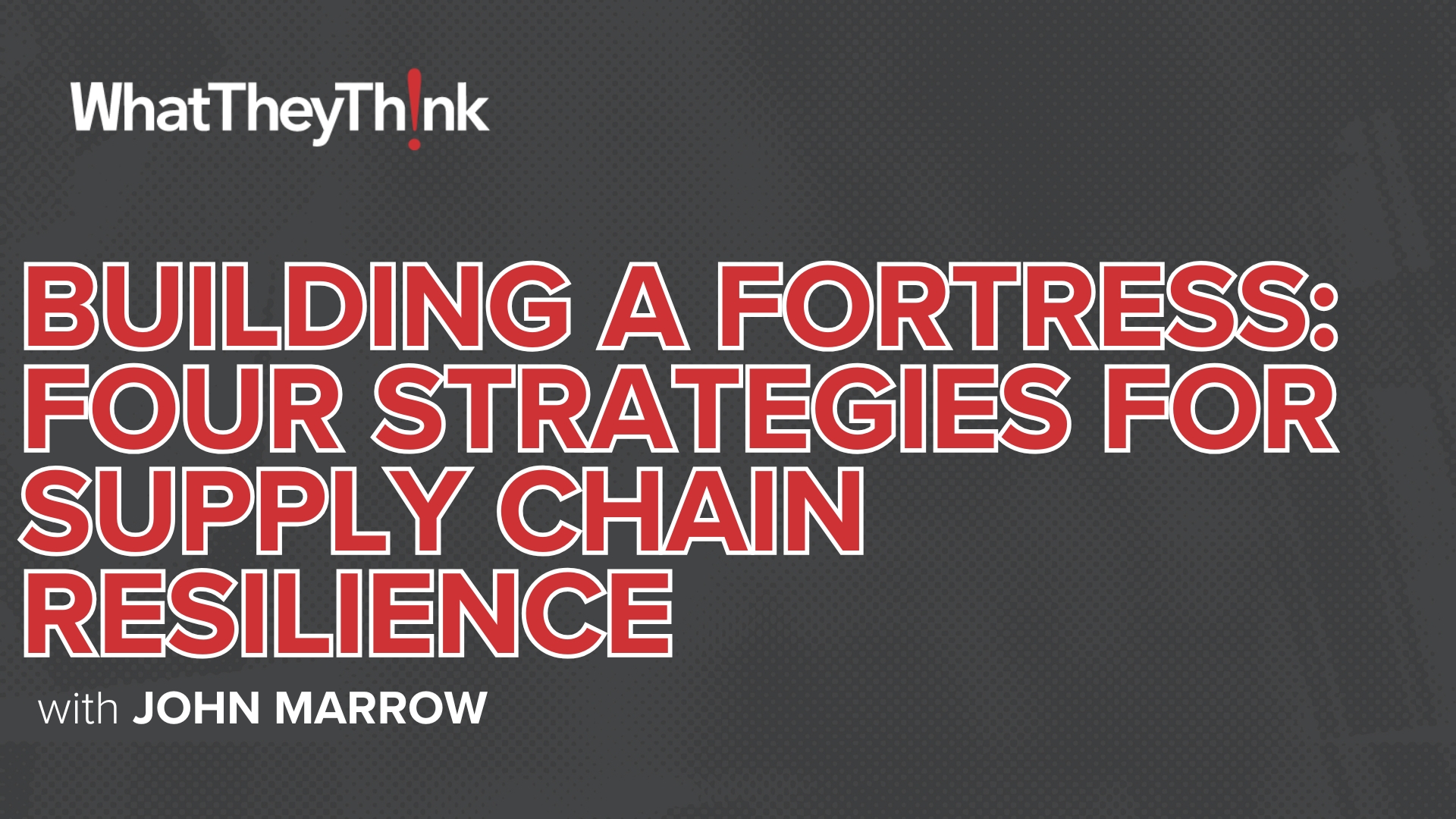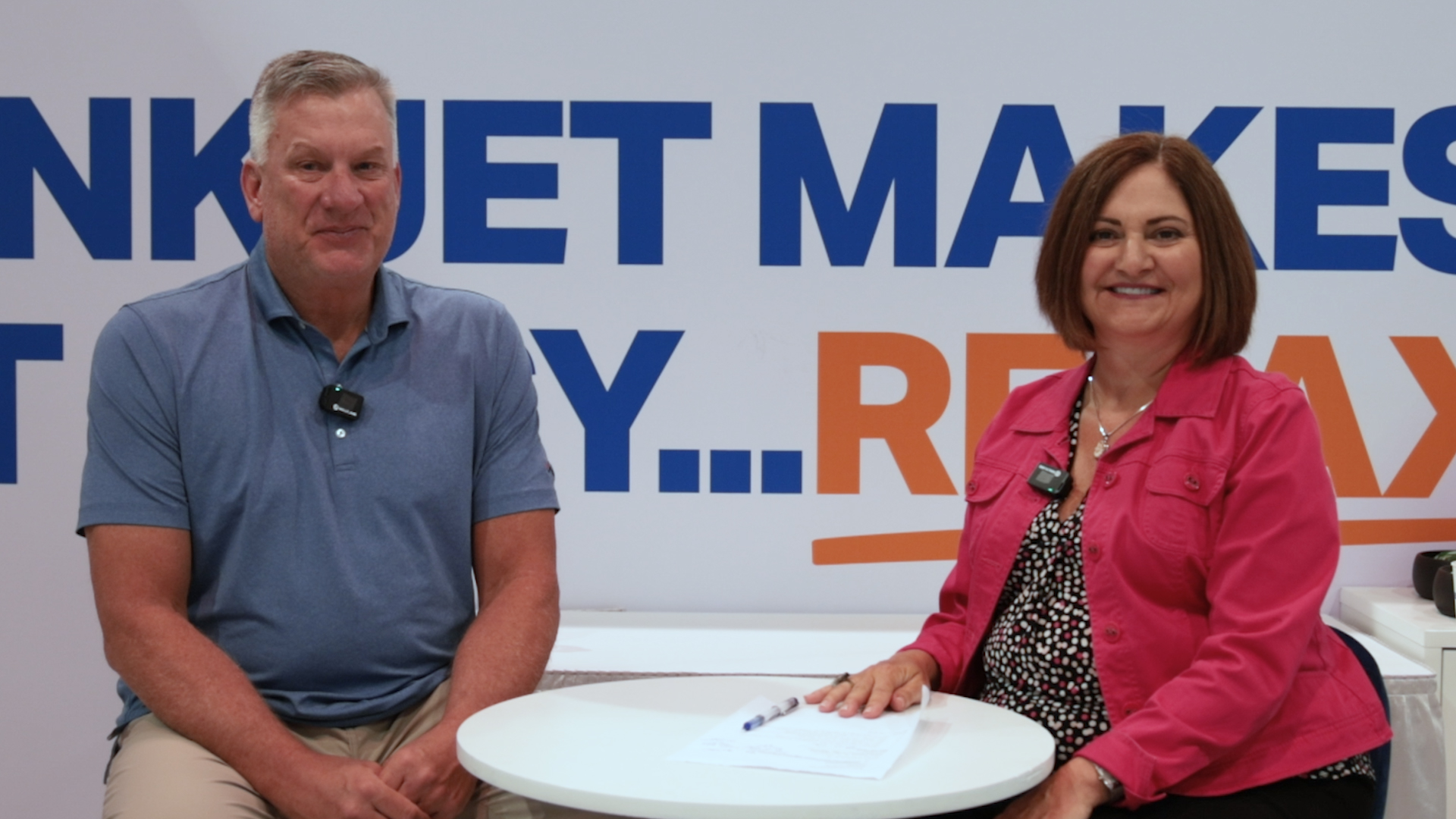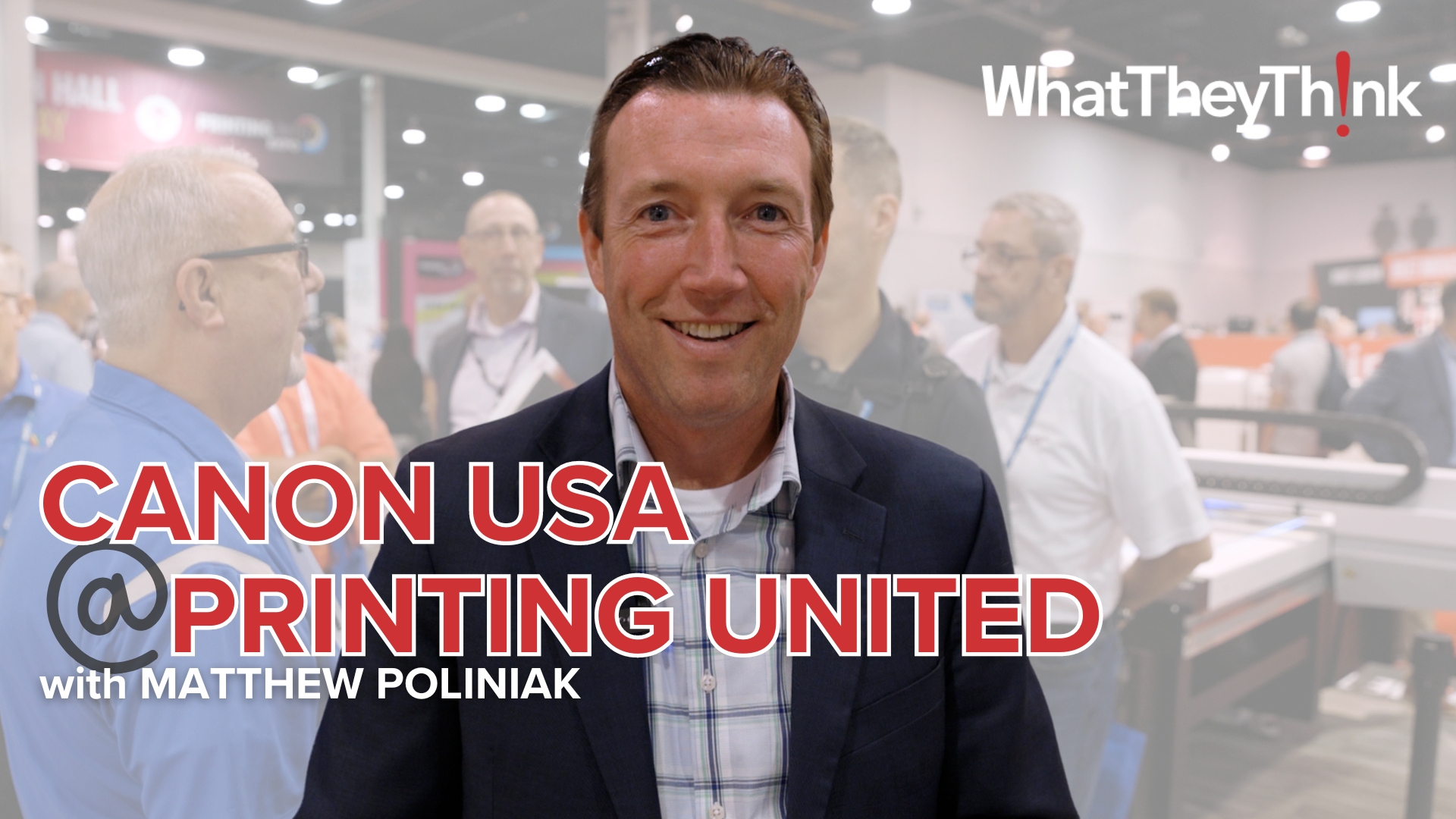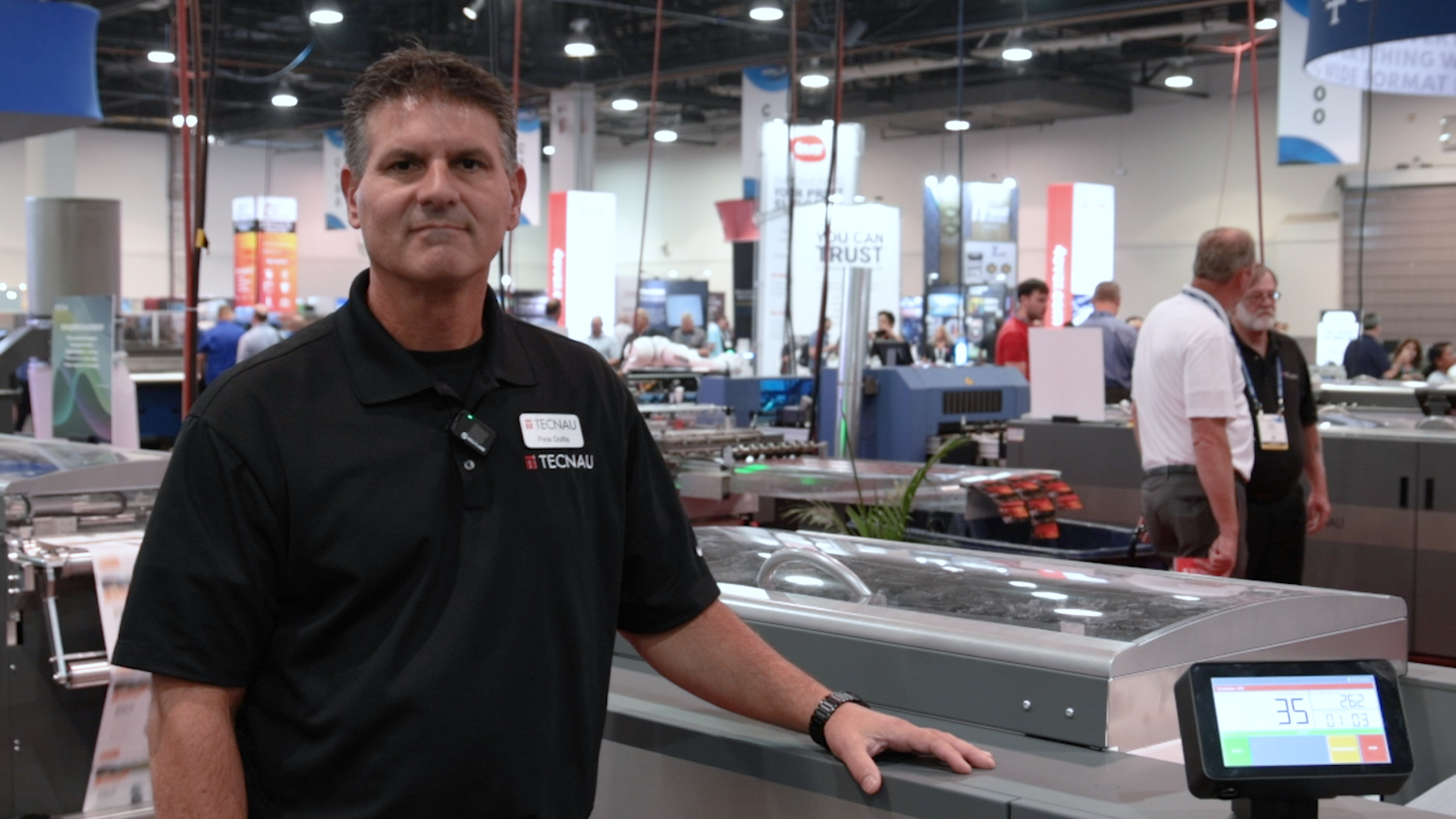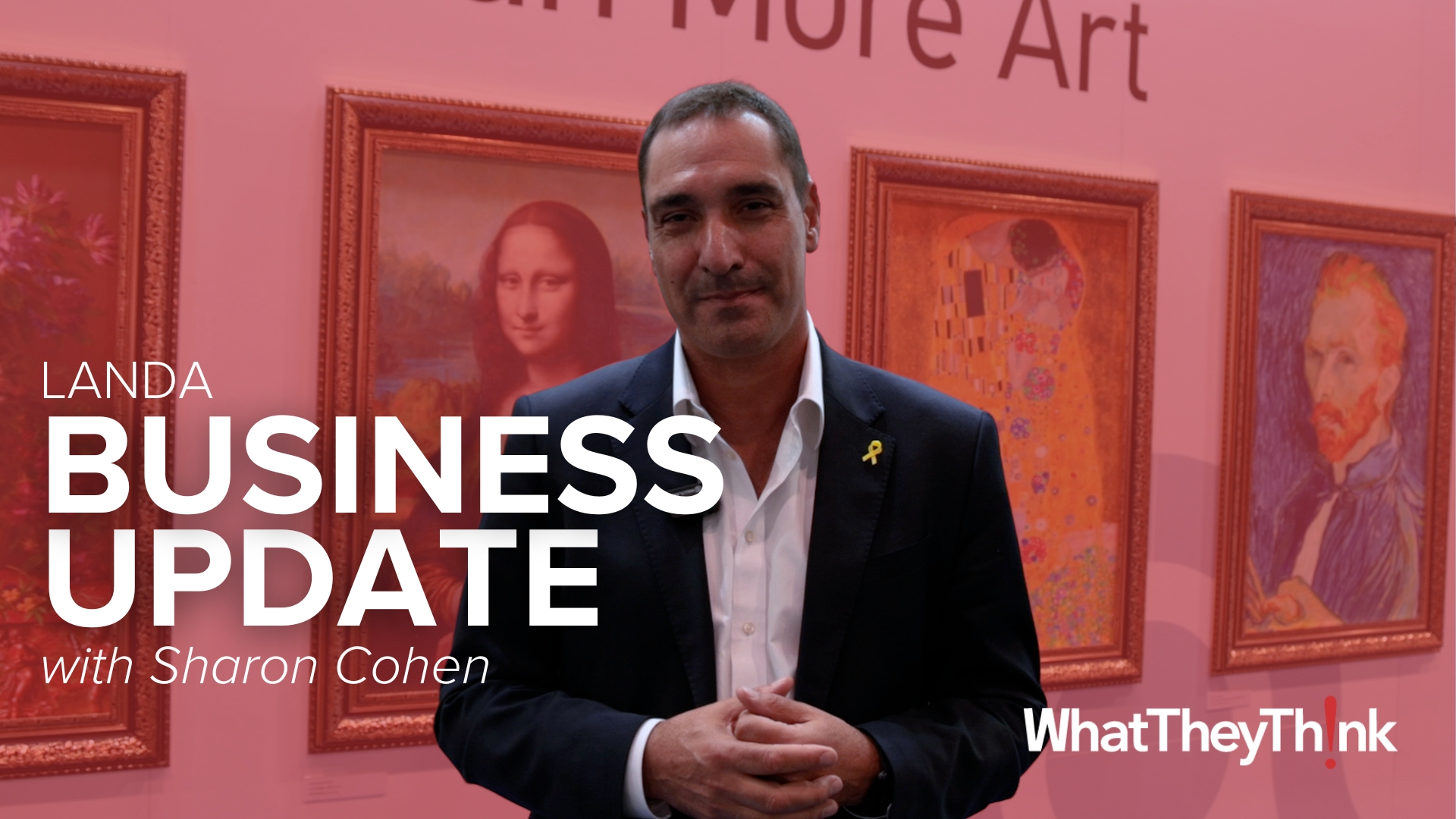Commentary & Analysis
Displaying 1151-1250 of thousands of articles
Insight You Need. Analysis You Trust.
Get the trusted insights you need to understand our evolving industry and emerging trends. Become a Premium Member.
Three Audiences, One Objective “Change”
Change can be difficult. You can make it a little easier by dividing up the constituents and hearing from their unique perspectives, basically giving them the airtime they deserve.
Cannabis Pros and Cons: Both in the Workplace and as a Print and Packaging Opportunity
Some printers are finding new growth in supporting cannabis marketing, communications, and packaging in the cannabis marketplace, but all printers need to be vigilant about the workplace issues brought about by the legalization of cannabis and its derivatives in many states. Contributor Lou Caron provides an overview of these issues.
Executive Q&A with Francis McMahon
We caught up with Francis McMahon, executive vice president at Canon Solutions America, Production Print Solutions, to talk about Canon’s growth areas, tease some new products and technologies, and explain how using the Grateful Dead as a business model has helped Canon succeed in the production inkjet market.
PRINTING United Preview: North American Debuts for Many Wide-Format Products
PRINTING United is slated for on October 19 to 21 at the Las Vegas Convention Center. As you may recall from past events, the emphasis of PRINTING United is on the “united” part, as it has been designed to be the venue where all the disparate “silos” of the industry—commercial, wide format, packaging and labels, textiles, industrial—come together under one very large roof. The following round-up is a sampling of the wide-format introductions you’ll find on the show floor.
Gallus One: Gallus and Heidelberg Go Full-On Digital
The integration of Gallus into Heidelberg is beginning to show impressive returns, starting with the Labelfire 340 hybrid press and now the Gallus One digital all-in-one label press, a jointly developed press and ecosystem. This new press is designed for the industry’s digital future and the new normal.
Johnson’s World: Listen, Part 13—Musings, Droppings, Streams, and Flashes
Vague musings, name-dropping, streams of consciousness, and occasional flashes of brilliance...from Johnson’s World.
It’s A Bird! It’s A Plane! It’s...Graphene: Get in on the Ground Floor with Graphene in Textiles
Graphene is a miracle material with the potential to revolutionize textiles. Senior editor Cary Sherburne takes a look at the current state of graphene-enhanced textiles.
Q2 Printing Profits: An End to the Tale of Two Cities?
Printing industry profits plunged during the pandemic peak but rebounded strongly afterward. But after hitting a peak in Q3 of last year, we’re on a downward trend, with annualized profits for Q2 2022 coming in at $3.92 billion, down a tad from $4.68 billion in Q1 2022.
Around the Web: Mammoth Manga. Number Nests. Royal Remaking. Virtual Voiceovers. Railway Redesign. Robot Rehab. Mouse Microbots. Averting Armageddon.
The longest book in existence is not designed to be read. House numbers that double as birdhouses. The arduous task of replacing Queen’s Elizabeth’s image on money, stamps, and products. An AI-powered speech engine for voiceovers. The complex design history of the London Unground map. BiaBrazil to integrate Graphene-Wear technology into women and men’s activewear. RIT researcher develops a humanoid robot that can teach humans tai chi. Swimming microbots clear pneumonia microbes from mice’s lungs. The James Webb Space Telescope captures details of spiral galaxy IC 5332. No need for Bruce Willis: NASA crashed a spacecraft into an asteroid to alter its orbit. A $10,000 first pumpkin spice latte engagement ring. All that and more in WhatTheyThink’s weekly miscellany.
The Eco Stories Textile Challenge to Feature at GREEN GRADS: 50+ Graduates with Ideas to Heal The Planet
50+ participants in the GREEN GRADS program shared their ideas to help heal the planet. Each submitted a portfolio with patterns that reflect their environmental concerns and/or love of the natural world, taking into account eco-friendly textiles, dyes, and methods of production. Green Grads is a not-for-profit event, organized with goodwill and with all time given freely. Read the full story.
Simple Strategies for Increased Sustainability
In addition to being the right thing to do, paying attention to increased sustainability can be a key differentiator in the value you offer to your clients and their brands. Sustainability is a system of change that is designed to protect our environment, and businesses of all sizes can play a role. This article explores some simple sustainability efforts that you can take today.
Executive Q&A: 4Over Demonstrates Continued Growth with a Broad Services Portfolio
4Over is the largest trade-only printer in the United States with 10 locations and close to one million square feet of production space and 1,100 employees. The company offers offset, digital, and wide-format printing, covering a wide range of customer applications. Cary Sherburne talks with CEO Shaheen Javadizadeh, who joined the company in 2020 from the enterprise software industry, about company updates and industry insights.
Interactive Print: What’s Working in the Real World? (2022)—Part 2
Summary of the second half of WhatTheyThink’s August 24 webinar “Interactive Print: What’s Working in the Real World (2022),” moderated by Heidi Tolliver-Walker and featuring presenters Joanne Gore of Gore Communications and Joe Zeff of Joe Zeff Design. Part 2 of the wrap-up focuses on Zeff’s presentation on his use of augmented reality in his Pittsburgh-based graphic design business.
Sales-Driven Change
You have change agents: they are your sales team. A group of people who are selling change every day. Use that team to help sell internal change whenever possible.
The Leadership Void
In previous articles, Wayne has discussed the worldwide issue of employee disengagement: what it is, what causes it, and how pervasive it is. This article begins a look at root causes. First up is poor leadership, which stems from poor decisions relative to who gets hired, promoted, and developed as leaders for the future. Effective leaders are the only people in an organization who can change the conditions that lead to disengagement.
Labelexpo Americas 2022 Part 2: The Rise of Digital
Labelexpo cemented the reality that digital is very much on the rise and at lightning speeds. The digital equipment is getting more sophisticated and, more importantly, productive. Digitalization is what will provide the platform for the new normal.
Are Fast Fashion Retailers Heeding Environmental Concerns or Still Trying to Sell More Stuff?
In this space, and across many other industry spokespeople, the call for an end to fast fashion has been resonating loudly. But are the brands and retailers—and consumers—taking this call for a reduction in unnecessary consumption seriously? It seems not.
Stargazing
Who are the sales “stars”? In your business? What qualities make them stars? David Fellman explains how to use those qualities to help motivate your less-stellar employees.
Around the Web: Count Conundrum. Lighting Leech. Floppy Fever. “Armor All”? Stick Solution. Carbon Kicks. Fruity Fashion. Hole Hoard. Ring Revelation.
How long should an article be? “Parasitic signage.” The floppy disk is, improbably, still in great demand. Graphene-based waxes and polishes for car detailing. A hand-crafted book about embroidery that was itself embroidered. Solving the problem of disposable chopsticks. New sneakers made from carbon emissions. A non-Pantone Color of the Year: Apricot Crush. An alternative to the skyscraper. An extensive online catalog of manhole covers from around the world. The Webb Telescope takes new pictures of Neptune. All that and more in WhatTheyThink’s weekly miscellany.
Pre- and Postpress Establishments—2010–2020
According to the latest, recently released edition of County Business Patterns, in 2020 there were 1,168 establishments in NAICS 32312 (Support Activities for Printing). This represents a decrease of 44% since 2010. In macro news, AIA’s Architecture Billings Index (ABI) indicates that demand for design services accelerated in August, boding well for commercial real estate construction and thus signage projects.
Best Practices for Alzheimer’s-Friendly Signage
September is World Alzheimer’s Month—and September 21 was World Alzheimer’s Day—where people and organizations around the globe raise awareness of Alzheimer’s disease and other kinds of dementia. As part of this awareness, UK-based print and branding company Solopress circulated some best practices for designing and producing Alzheimer’s-friendly signage and display graphics.
The Wallcoverings Industry Is Set for Disruption and John Mark Ltd Is Leading the Field
One of the trends that emerged from the pandemic was an increased focus on décor -- home, office and otherwise. And that included a resurgence in interest in wallpaper. New technologies, including high quality production inkjet printing and equipment designed specifically to output short runs of customized wallpaper, have made it easier than ever before to produce bespoke wallpaper. And designers and producers alike are taking advantage of this trend. In this article, compliments of textiles expert and WhatTheyThink contributor Debbie McKeegan, we highlight the work of John Mark Watson of John Mark LTD as an inspiration to others.
Changing Your Customer’s Behavior
Your customers require selling even after they are customers. The selling comes in the form of encouraging them to engage with you in a way that is both convenient for them and improves the outcomes of your workflows.
Interactive Print: What’s Working in the Real World? —Part 1
Summary of the first half of WTT’s August 24 webinar “Interactive Print: What’s Working in the Real World (2022),” moderated by Heidi Tolliver-Walker and featuring presenters Joanne Gore of Gore Communications and Joe Zeff of Joe Zeff Design. This article focuses on Gore’s presentation looking at the evolution of QR Codes from misused novelties to truly useful marketing tools and how to use them successfully.
Labelexpo Americas 2022 Part 1: The Times Are Changing
The level of excitement mirrored the general mood of the industry, and “we’re back but different” was the underlying theme of this event. The takeaway was there is no turning back and rapid change is the new normal, with digitalization as the lifeblood of the infrastructure.
What Print Sales Job are You Looking For?
While hiring sales team members requires art and science, at the same time, candidates for sales positions also need a strategy to make sure a particular job is aligned with your abilities. Pat McGrew explains how job-seekers can ensure that they are the best fit for a given position and company.
Fiery Preflight Pro: Troubleshooting Jobs “Within” the Workflow
EFI Fiery DFEs have been driving digital printers for over 30 years. As the digital printers and the market requirements they serve change, there is a need to bring more automated preflight to the production floor to ensure process consistency, EFI has ensured that their DFE meets those challenges with their customers in mind. This includes the newly released Fiery Preflight Pro, available for Fiery FS500 Pro and newer servers.
Czech-based GrapheneUP Jumps into Textiles
As we have been discussing in this space, graphene, a miracle material discovered in 2004, has begun to make inroads into the textiles industry, with a growing number of products that are graphene-enhanced, either with coatings, inks, or covalently bonded to the base fiber. We recently came across Czech-based GrapheneUP, who has added graphene-enhanced inks and coatings for textiles to their product mix.
HP Pagewide T700i Packaging Press: A Lot More than Corrugated Preprint
HP has announced a new PageWide packaging press that has a print width that fits nicely between their existing T400 and T1100 series presses corrugated preprint presses. However, the new T700i is designed for more than just corrugated preprint.
Printing Shipments: July Takes a Tumble
July 2022 shipments came in at $6.68 billion, down from June’s $6.98 billion, as the dog days of summer kicked in.
Around the Web: Blueprint Buddy. Better Bags. Tone Test. Plural Panoply. AI Art. Dead Dialogue. Insect Info. Finger Fun. Noodle Napping.
HP’s SitePrint robot for construction site printing. Graphene-enhanced bags for food storage offer greater strength and less weight and thickness. X-Rite’s quick online color IQ test. Why does English have so many different ways of pluralizing nouns? AI fails at reproducing classic works of art. Creepy AI grandma talks from the dead. Oh, NASA, we beg you not to crowdsource the name of the new Uranus Probe. Telling Queen Elizabeth’s bees about her passing. Lenovo’s new “virtual monitor” glasses. The James Webb Telescope captures a stellar nursery in the Tarantula Nebula. Creating wooden claws that fit over your fingers. A “blanket” based on udon noodles. All that and more in WhatTheyThink’s weekly miscellany.
Print’s Role in the Digital Transformation
The digital reality has caused a shift in communication strategy, and the focus should be on improving the customer experience with superior interaction. Businesses may feel compelled to ramp up their digital communication strategies in response to consumers’ demands, but print can—and should—play a role in communications of the future. This article explores how printed communications can be used strategically to improve the customer experience.
A Guide to Eco-Friendly, Sustainable Fabric and Textile Printing—Print Customers Are Increasingly Requesting Greener Materials
What's the latest advice for sign and display graphics operations that want to print soft signage more sustainably? In this article written by Ella Faulkner of Soyang Europe, provided compliments of textiles expert and WhatTheyThink contributor Debbie McKeegan, it is pointed out that public sector spaces are under ever-increasing pressure to offer a sustainable environment filled with sustainable products. So, too, are educational and health facilities. But the biggest market is found in retail where showing off green credentials is demanded by customers. The article explains what types of textile printing are greenest and technologies that can limit waste and reduce water and energy usage.
The Liberation that Comes from Implementing Process
Process or workflow documentation sounds like something only for very large bureaucratic corporations. This is not true. The smallest companies can benefit from process improvement. Your business is a series of processes that are repeated over and over.
In a Data-Driven World, Do Printed Forms Even Matter? Some Say Yes!
Even as we cover increasingly sophisticated digitally driven and data-driven applications, it’s important to remember that traditional business still exists. This includes business forms, and while that business is shrinking, it does still offer profitable pockets of business that commercial printers might want to explore.
What a Designer Can Learn from the Immersive Van Gogh Exhibit
ColorKarma’s Shoshana Burgett describes her visit to the Imagine Van Gogh immersive exhibition and explores how the exhibit’s unique approach to providing a user experience can be applied to industry events and consumers’ relationships with brands.
The Target Report Annual Review—August 2022 TTM M&A Activity
Viewed from the perspective of M&A activity in the printing, packaging and related graphic communication industries, we are in a post-pandemic sweet spot, business is going strong, and we are not yet significantly feeling the effect of inflation and rising interest rates. Packaging is still the red-hot segment, fueled by PE-backed roll-ups chasing fewer available top-notch producers. The commercial print, direct mail, and wide format segments are not as active, but desirable candidates attract a lot of attention and deals are getting done; and more…
What Do We Talk About When We Talk about Interactive Signage?
“Interactive signage” is changing from simply providing information to creating immersive experiences. At the same time, the actual mechanism by which a user interacts with a display is changing from simple physical interaction to electronic interaction.
Sparty Mill: Reviving Textile History
Are we starting to see a resurgence in the US textiles and apparel market? In a recent article, we addressed some of the activity relative to localized cut-and-sew operations, the “last mile” for apparel manufacturing. In this article, we take a deeper dive into what Hodges International has done with Sparty Mill to help this resurgence along.
Book Printing Establishments—2010–2020
According to the latest, recently released edition of County Business Patterns, in 2020 there were 379 establishments in NAICS 323117 (Books Printing). This represents a decrease of 29% since 2010. In macro news, highlights from the most recent Federal Reserve “Beige Book.”
Around the Web: Graphene Glut. Contested Contest. Printed Python. Color Commentary. Solar Solution. Tide Tidying. Eyeing Exoplanets. Cup Clarity.
New IDTechEx study finds the global supply of graphene exceeds demand—for now. An art contest winner used AI—fair play or cheating? Flashing back to a terrifying bus wrap from 2010. How did the colors get their names? Why is Dante the father of the Italian language—or William Caxton the father of English? “Solar trees” for EV charging. A “floating waste collector” drone for cleaning up the ocean. The James Webb Space Telescope took its first photo of a planet outside the solar system. A design for an easier-to-read measuring cup. Oscar Mayer has introduced a combination hot dog/popsicle, for reasons passing understanding. All that and more in WhatTheyThink’s weekly miscellany.
Meet Lily Elo: First Class Honors BA (Hons) Textile Design Graduate in 2022 at Nottingham Trent University
As part of our ongoing series featuring the next generation of textile designers compliments of textiles expert and WhatTheyThink contributor Debbie McKeegan, we welcome you to read about Lily Elo. Her current project INTERFERENCE focuses on the phenomena of light interference creating an iridescent color spectrum.
HP Introduces the Advantage Inkjet Platform and It’s Brilliant!
In 2006, HP commercialized its “Scalable Printing Technology,” and in 2008 they introduced the PageWide T300 production inkjet press. Now, 14 years later, with the benefit of a lot of company and customer experience, they are introducing a newly designed high performance press platform.
All Arise! Americas Print Show Hints at the Future of Events
The inaugural Americas Print Show was held August 17–19, in Columbus, Ohio, and while it had some hiccups, the general consensus, from exhibitors and attendees, was that it was a worthwhile event. What does this tell us about the future of industry events?
Sleep Number Sees 44% Incremental Sales Increases with Retargeted Direct Mail
For Sleep Number, direct mail retargeting is nothing new. A switch to a new partner, however, has turbo-charged its success, and it is now seeing 44% incremental sales rates.
Your Building Foundation vs. Your Software/Digital Foundation
Physical foundation has been our collective focus for decades. The print industry creates physical products using physical machines. Digital foundation is our new differentiator: data and systems create new business opportunities and enable you to run your business more efficiently.
Who Are You Hiring for Sales?
Hiring sales team members requires art and science. Pat McGrew talks about adopting a hiring strategy that is in sync with your sales goals.
The First Graduates of the Mariano Rivera Foundation Printing Vocational Training Program Are Ready
The Mariano Rivera Foundation brings mentorship, life skills, STEM education, and vocational training to at-risk youth. Thanks to support from industry vendors such as EFI, KonicaMinolta, Ricoh, Idealliance, Printing United Alliance, and Adobe, it will funnel much needed talent into the printing industry, as well. Heidi Tolliver-Walker provides an update on the first class of graduates.
Graphic Arts Employment Up Slightly in July
In July 2022, all printing employment was up +0.7% from June. Production employment was up 0.2% and non-production employment was up 1.8%.
Around the Web: Problematic Print. Mail Merch. Code Complaints. Display Developments. Textile Tech. Meteorology Melee. Cream Confusion. Galaxy Gazing. Table Tournament. Gravy Grappling.
What is a print-based physical disability? Play the USPS’s new Great American Mail Race board game. What is the future of QR code menus? The Bigme InkNote Color brings E Ink devices closer to competing with LED-based tablets. AI illustrates lyric music videos. New graphene-based “smart textiles” hit the market. Hungary punishes inaccurate meteorologists. No, New York State has not banned selling whipped cream to minors. The James Webb Space Telescope does a Cartwheel. “Competitive table setting.” Gravy wrestling is back! All that and more in WhatTheyThink’s weekly miscellany.
Printing with a Higher Purpose: Women’s Press Collective
Contributor Patrick Henry profiles a Bronx-based, all-volunteer organization that demonstrates why print remains foremost among the media as a force for social good.
Direct-to-Garment Printers Are Blurring the Lines Between Commercial and Industrial
If you’ve been paying attention to some of this year’s new DTG printer launches, you may have noticed that the traditional gap between commercial and industrial printers appears to be closing. Today’s DTG devices are delivering faster printing speeds, better print accuracy, and more advanced technologies—all with a smaller footprint and a lower price tag. This article offers a brief overview of the devices that are blurring the lines between commercial and industrial printers.
The Lighthearted Side of QR Codes
Even as the use of QR codes has become normalized thanks to the COVID-19 pandemic, we still see some pretty bone-headed implementations. A look at three use cases in light of three important best practices.
US Debut & Launch of Super Lightweight Magnetic Cylinder Aluminum by Rotometal at LabelExpo Americas
In this article, written and sponsored by Rotometal, learn about the company that will make its North American debut at the LabelExpo Americas 2022 event and launch their super lightweight Magnetic Cylinder Aluminum.
Requesting a Demo of Print Software
The software demo is typically a key to the decision-making part of the sales process. Your definition of your core challenges before the demo can greatly influence ROI outcomes in the future.
Selling to Lapsed Customers
Do you have accounts who used to be profitable, high-volume customers but haven’t ordered from you in a while? Pat McGrew explains how to bring lapsed customers back into the fold.
A Matter of Responsibility: Know Why You’re Checking in on Your Clients
It is never the buyer’s responsibility to communicate with the seller. It is always the seller’s responsibility to communicate with the buyer. Contributor Dave Fellman explains how to establish a “contact interval” for your most important customers.
A U.S. Cut-and-Sew Boom?
One of the key barriers to reshoring textiles and apparel has been the lack of sewing talent, the final mile, if you will, of localized apparel and home décor manufacturing. Recently we have seen a number of new cut-and-sew operations pop up across the nation, an encouraging sign for the future of the American textiles and apparel industry.
Get on the Same Page: Pre-Call Prep Leads to Better Prospect Meetings
Most salespeople agree that advance prep for important prospect meetings is a precursor for successful call outcomes—and the statistics confirm that sellers can gain at least a 20% bump in productivity through consistent pre-call work. Contributor Lisa Magnuson explains how to effectively prep for your sales call.
Screen Printing Establishments—2010–2020
According to the latest, recently released edition of County Business Patterns, in 2020 there were 5,563 establishments in NAICS 323113 (Commercial Screen Printing). This represents an increase of 25% since 2010. In macro news, 2Q GDP revised up to -0.6%.
Around the Web: Preserving Painting. Brand Bios. Denim Dyeing. Golden Graphene. Drought Displays. Phone Fun. Rainless Rides. Mill Meal. Hair Hoopla. Spicy Smooching.
Keeping the art of traditional sign painting alive. A comprehensive book on the history of brand logos. A new, more sustainable approach to blue jeans production. “Graphene turns rubbish into gold, literally.” Record droughts are revealing all sorts of hitherto hidden relics in the world’s bodies of water. An interactive site where you can design the next iPhone. “Would you eat a windmill?” NASA’s James Webb Space Telescope captures new detailed images of Jupiter. The USA Mullet Championship, for some reason. “The practical utility of equipping cats with laser beams.” Applebee’s new chicken wing sauce flavored lip gloss. All that and more in WhatTheyThink’s weekly miscellany.
Textile Technology Highlights S/S 2022: Trailblazing Innovations and New Developments
With the return of in-person trade shows and events in 2022, suppliers to the industry have plenty of technical developments on display, and the industry is poised to see accelerated growth and a continuing transition to digital technologies. In this article, textiles expert and WhatTheyThink contributor Debbie McKeegan highlights a few of them.
ISA’s Upcoming Sign Manufacturing Day Offers Sign Businesses Employee Recruitment Opportunities
On October 7, sign companies will have an excellent opportunity to potentially attract new and young talent to their businesses. Every year, on the International Sign Association’s (ISA) Sign Manufacturing Day, participating sign shops host open houses, facility tours, and hands-on demonstrations for students to show them the opportunities that exist in the sign business.
Study: Getting Personalization Right
Movable Ink’s second annual Audience of One consumer survey has many takeaways. It continues to confirm what we’ve known for a long time: Consumers want you to market to an audience of one. But it has some other takeaways about customer loyalty and customer preferences related to product purchases that are just as important.
Finding the Critical Path in Your Assembly Line
You run a print factory, you have an assembly line—find the critical path, then find what’s standing between you and your cash flow. Don’t be surprised if it's way upstream of your press.
In the Driver’s Seat: Increasing Print Business with Augmented Reality
It’s finally happened. Print and marketing firms are incorporating augmented reality (AR) into their marketing tool kits. Not just for fan engagement and brand building, but as a business problem-solving and revenue-driving solution. Far from AR competing with print, it’s driving it. Contributor Heidi Tolliver-Walker looks at several case studies that launched AR experiences from print.
Mapping the Future of the European Paper Market
The current paper shortage and price rises are the result of long-term trends in the paper industry that got upended by the pandemic and the recovery. European section editor Ralf Schlözer looks at the current situation, how we got here, and if and when paper problems will be alleviated.
QR Codes: Teleporting Print Into the Metaverse
By making it easier for people to engage with print via a simple, interactive element, QR codes bridge the physical with the digital, teleporting them to their destination in an easy and fun way. Contributor Joanne Gore explains how QR codes transform print from a commodity to a high-value communications tool capable of linking to videos, landing pages, special offers, podcasts, and more.
How Serious Is the Fashion Industry about Sustainability? And What Role Does Trade Journalism Play?
In this space, we have had a great deal of discussion about sustainability, supply chain, and the need for dramatic change in the textiles and apparel industry. In today’s article, we look at some of the important research and journalistic organizations that are helping drive this change, the important role they play, and some of their upcoming events.
Printing Shipments: The Best June Since the Before Times
June 2022 shipments came in at $6.98 billion, up a tad from May’s $6.96 billion. This is the best June the industry has had since 2019—although it’s well below that month’s $7.54 billion.
Around the Web: Paper Properties. Sign Slight. Tape Trick. Choice Charging. Dog Design. Bubble Ballad. Termite Taste. Pumpkin Palate. Candle Cuisine. Mollusk Minder.
Zapping a Gutenberg Bible with X-rays to see if Gutenberg learned about printing from Korea. Magnetic signage helps Mexican street food vendors circumvent new sign prohibitions. Converting Scotch tape packaging into a tape dispenser. Dell’s graphene-enhanced wireless charging clip. A typeface in which each letter is a dog. A music box that plays music by popping Bubble Wrap. Will 100,000 termites eat fast food? Taste test Trader Joes autumn food products and earn $1,000. Ultrarealistic candles that look like food. Immobilize your toddler with Walmart’s octopus baby outfit. All that and more in WhatTheyThink’s weekly miscellany.
Why Are Live Workshops So Powerful? We Interview Jason Burroughs of Perfect Colours to Find Out More
Live events are back in play and here to stay! They support and connect the print community by providing a window of opportunity where networking and the transfer of knowledge go hand-in-hand. Textiles expert and WhatTheyThink contributor Debbie McKeegan talks with Jason Burroughs, Managing Director of Perfect Colours, about why their workshops offer the visitor such a valuable experience.
Print Buyers: Fitting Into a Digital World
Earlier this month, Keypoint Intelligence published the findings from its in-depth survey of over 200 print buyers in the United States. This article offers a high-level overview of our survey results to illuminate print’s changing role in the overall ecosystem.
It’s Time to Talk About NFTs
What, exactly, are NFTs? Do they matter to us in the printing industry? This article offers a simplified explanation of NFTs and examples of what they look like in the real world.
Looking Down: A Floor Graphics Application Gallery
In this photo gallery, we highlight some recent floor graphics projects that display graphics providers have produced. These application galleries are intended to serve as “food for thought” in developing creative applications for clients.
Doubling Down on the Print MIS/ERP You Own
Print MIS/ERP systems are a favorite thing to complain about and be frustrated with. This week I am trying to do the impossible: get you to double down on the Print MIS/ERP you currently own instead of throwing it out and starting over.
Smart Retail: AI in the Produce Section
David Zwang looks at the rise of retail locations featuring checkout-free virtual cashiers. Convenience or “Big Brother”?
Let’s Fire Some Customers!
Your sales plans should reflect what you sell, how you sell, and your target customer profile. A deep dive into your customer list is the only way to evaluate which customers help you produce a profit and which may cost you money. Pat McGrew explains how to sort the good customers from the bad—and how to fire those that may be costing you money.
Think Cast Vinyl Is a Must for That Project? Think Again
With myriad supply chain issues, some materials are harder to obtain than others. One such material is cast vinyl. However, for some applications, calendered vinyl—which is more readily available and more cost-effective—can be substituted for cast. This article, sponsored by FLEXcon and written by FLEXcon’s Jodi Sawyer, identifies where calendered vinyl is an acceptable substitute.
Will Supply Chain Issues Help Drive Major Manufacturing Change in Apparel?
Before the pandemic, I never dreamed I would be writing about supply chain so often. But then, before the pandemic things were different…or were they? The problems were there back then, but they were exacerbated and brought to the forefront due to pandemic-related issues. With all the supply chain noise, we wondered whether there would actually be meaningful solutions soon, and/or whether reshoring and digital production would be accelerated. A Forbes article on the topic sheds some light here.
Around the Web: Test Test. Silly Stickers. Perilous Plants. Cola Cartridge. Raincoat Reservoir. Parasol Power. Better Buds. Spider Sleep. Dog Dudes.
Your expired COVID tests may have been given an extension. An epidemic of really bad forged car inspection stickers. When in the UK, visit The Poison Garden—but carefully. The Cana is a countertop “beverage printer” that can replicate many different flavors using a single cartridge. “Celebrate rainy days” with a rainwater harvesting coat. A solar-powered umbrella that can be networked. Graphene-enhanced earbuds. New evidence that spiders may dream. The World Dog Surfing Championships. Another roadside attraction…or two. All that and more in WhatTheyThink’s weekly miscellany.
Commercial Printing Establishments—2010–2020
According to the latest, recently released edition of County Business Patterns, in 2020 there were 16,283 establishments in NAICS 323111 (Commercial Printing except Screen and Books). This represents a decline of 26% since 2010. In macro news, inflation is flat!
Textile Sustainability Spotlights S/S 22—Innovations and Insights
In this article, compliments of textiles expert and WhatTheyThink contributor Debbie McKeegan, we take a look at textile sustainability innovations and insights, with a focus on the supply chain, greenwashing, and truly sustainable initiatives.
Direct-to-Plane Printing?
The Southwest Research Institute (SwRI) has developed a prototype robotic inkjet printing system that can print directly onto three-dimensional surfaces—specifically, airplanes. Richard Romano spoke to SwRI Senior Research Engineer Branson Brockschmidt about the project.
AR Has Reached a Tipping Point: Now What?
Augmented reality has reached a tipping point, and it’s one that is increasingly affordable, accessible, and highly relevant to even the average print shop. AR has become a way to offer solutions and help your clients sell products and engage audiences in real, practical ways.
Selling Features to Your Print Business Software Vendors
Doing a little more work on feature requests can have an oversized impact on the likelihood of getting into a product roadmap.
Imprimu Brings Online Print to Latin America
Online print is a major growth segment in the printing industry, but its market success has been country- or region-dependent. While in many European countries online print already has double-digit revenue share, in other regions—like Latin America—the share is fairly small. Start-up company Imprimu is preparing to change this, starting from their home base in Panama. Ralf Schlözer takes a look at this new start-up.
Spoonflower: One Year Later
Shutterfly acquired Spoonflower one year ago. Senior editor Cary Sherburne checks in with the company for a progress report.
Fashion Faces Growing Greenwashing Scrutiny
Greenwashing is rampant in the fashion industry, but there is growing scrutiny on this unethical practice. Will it be enough to reduce the tide of discarded clothing and other textile items that are burned or dumped in the landfill? Will we really get to any kind of circular life cycle for fashion? There are encouraging signs, but we are far from reaching any kind of critical mass.
Bucket List: Signarama Downtown Louisville (Ky.) Wins Best in Show at Signarama Sign Awards
Sign franchise Signarama’s Best in Show award this year went to Signarama Downtown Louisville (Ky.) for a project that involved designing, constructing, and wrapping a giant KFC bucket for Louisville-born rapper Jack Harlow.
The Target Report: Cenveo Returns to its Roots—July 2022 M&A Activity
Burton Family Cements Control, Envelopes are in Demand, and more…
June Graphic Arts Employment—The Production/Non-Production See Saw This Month Favors Non-Production Workers
In June 2022, all printing employment was up +0.2% from May. This time, it was production employment that was down (-0.8%) and non-production employment that was up (+2.3%).
Around the Web: Rapid Rotation. Sheep Shipping. Recommended Reading. Keeping Calendars. Casino Clock. Clever Key. Hometown Heroes. Car Cluster. Faux Fax. Balloon Bistro. Velveeta Vodka.
The Earth is spinning faster than ever—and no one knows why. New Bubble Wool packing material made from discarded wool. “Recommendmeabook.com” lets you try out first pages of books. Graphene foam-based sensors for better prosthetics and robotics. New site tells you in what year you can reuse a calendar. A 3D-printed flip clock that uses playing cards to display the time. A redesigned door key that makes it easier to orient. Interactive map lets you find famous people from your hometown. A flock of self-driving cars mysteriously show up at the same corner and idle…ominously. Remember when urban legends and conspiracy theories spread by fax? The first hot air balloon-based restaurant. “La Dolce Velveeta” heads to happy hour with the “Veltini.” All that and more in WhatTheyThink’s weekly miscellany.
From Kit Miles To Sebastian Cox—Barbara Chandler’s Photo Gallery at the New Designers Expo Celebrates 37 Years of Creative Talent
Design writer, curator, and photographer Barbara Chandler, who has been writing about design and decoration for more than 40 years, has documented the New Designers in Residence program at the Business Design Centre in Islington, UK. She has meticulously recorded their details in an ongoing commentary on Flickr and has a huge archive going back some 15 years. In this article, provided by textiles expert and WhatTheyThink contributor Debbie McKeegan, you will see and learn about the program and some of her favorite images.
Taking the Guesswork Out of Social Media Marketing
Social media has proven itself to be an effective tool for brand marketing, and an online presence is now critical for businesses of all shapes and sizes. Given the importance of social media in today’s business climate, it’s not uncommon to feel a bit overwhelmed when attempting to establish or improve your position in the playing field. This article considers some of the most common challenges associated with social media marketing and offers some tips for navigating them.
Planning Video? Think “Postcard,” Not “Speech”
As video continues to grow as a marketing tool, often eclipsing text and images in terms of its power and effectiveness, there has been a rush to embrace it. But video isn’t like print or other marketing content. It’s its own animal, requiring dedicated focus by printers and their clients looking to capitalize on its power.
Your Technology Stack Conflicts with the Workforce Age
There are a lot of differences among the different demographic groups in the labor force colliding right now in your print business. The most critical for your business is both the access to technology throughout their lifetimes and the rate of change of technology in their lifetimes.
Johnson’s World: Sounds Like a Dry Martini—The Art of a Good Blog
No matter the medium, solid content will get the attention of your prospects. No amount of animation, keywords, or pretty pictures can hold audience attention without good content.
How’s Your Sales Plan Working? Buyers and Discounting
We are well into the second half of the calendar year, and to ensure a profitable end to your year, take a few minutes to look at what is in your pipeline, what has been onboarded, and what is in production. Is it what you expect? In part two of a two-part series, Pat McGrew takes a deep dive into the costs of doing business with customers and how you apply discounting strategies.
Bobst Going Private to Focus on the Future
Going private again, and being in a position to select and negotiate any financing needs beyond what JBF Finance SA can provide on its own, should minimize and streamline the undue reporting burdens of a public company, and allow Bobst to innovate and focus on the company’s present and future.
- Questions to ask about inkjet for corrugated packaging
- Can Chinese OEMs challenge Western manufacturers?
- The #1 Question When Selling Inkjet
- Integrator perspective on Konica Minolta printheads
- Surfing the Waves of Inkjet
- Kyocera Nixka talks inkjet integration trends
- B2B Customer Tours
- Keeping Inkjet Tickled Pink
© 2024 WhatTheyThink. All Rights Reserved.


